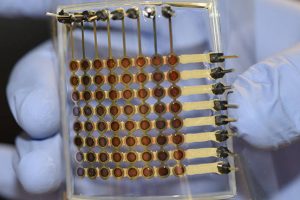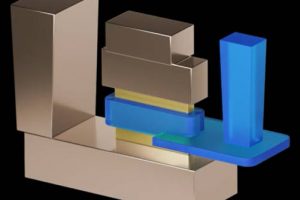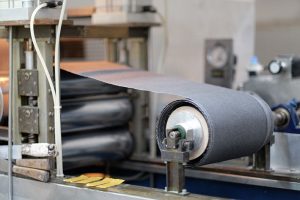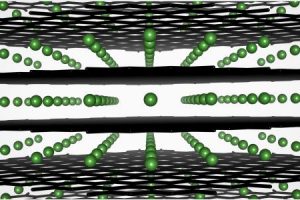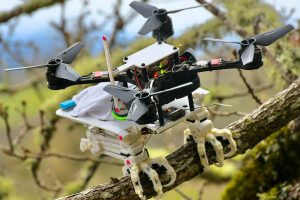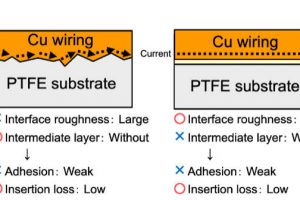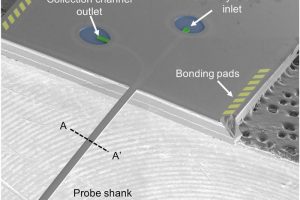To prove it can be done, researchers at the University of Minnesota Twin Cities has 3D printed everything in a flexible OLED display, except for the plastic sheet it was printed on. The 64 pixel display is around 40mm across “OLED displays are usually produced in big, expensive, ultra-clean fabrication facilities,” said Minnesota professor Michael McAlpine. “We wanted to see ...
Research
The latest electronics research news from within the industry and universities from around the world.
IBM beats finFETs with vertical CMOS at IEDM
IBM revealed vertical FET CMOS logic at a sub-45nm gate pitch on bulk silicon wafers at the IEEE International electron devices meeting in San Francisco this week. IBM’s VTFET with a vertical channel (yellow) and gate-all-around (blue). Contacts are brown and the white line shows current flow. It calls them VTFETs, for vertical transport FETs, and is describing the channel cross-section ...
Intel harnesses R&D to realise its process ambitions
Intel has shown IEDM some of its research routes aimed at propelling the company to industry leadership in manufacturing technology by 2025. Intel has put a lot of money and effort into packaging. In the last seven months it has announced investments of $10 billion in its Rio Rancho and Penang packaging plants. At IEDM it described its approach to ...
Gait singles you out pretty well, according to your phone
Smartphones can be 85% accurate in identifying who is carrying them, merely by detecting motion as the person walks around normally, according to the University of Plymouth. This rises to almost 90% if they walk fast. The trial had 44 participants, aged between 18 and 56, each carrying a phone in a belt pouch for 7 to 10days. Resulting phone gyroscope ...
SiGe analogue FIR filter for microwave and mmW
Georgia Tech has developed a general-purpose MMIC (monolithic microwave IC) for the direct filtering and processing of microwave and millimeter-wave signals. The aim is to reduce radio power consumption by swapping some digital signal processing elements for reconfigurable analogue processing blocks. “High-speed digitisation blocks targeting microwave frequencies are expensive and consume a lot of power,” said Georgia Tech researcher Nelson ...
Supercapacitor electrodes made of organic material
Sweden’s Digital Cellulose Center is storing electricity on ‘electronic paper’ completely made of organic material. The ingredients are cellulose, conductive polymers and bio-based charcoal from coconuts, and the result is durable, electrically conductive and has a large surface area structure that can bind energy-storing materials. Update: Supercapacitors with cellulose active material on paper substrates “Our goal is to use the ...
Another reason why Li-ion cells don’t like fast charging
Argonne National Laboratory has been looking into lithium-ion cells in great detail, and its scientists have found a nano-scale deterioration mechanism to add to the reasons that fast-charged Li-ion batteries degrade in electric vehicles. In use, lithium ions move in and out of the anode, which is usually made from graphite particles. The ions slide between the carbon atoms in ...
Bird robot perches like the real thing, and catches prey
Stanford University engineers have created a robot bird that can use its feet to perch and carry things. “It’s not easy to mimic how birds fly and perch,” said Stanford engineer William Roderick. “After millions of years of evolution, they make take-off and landing look so easy, even among all of the complexity and variability of the tree branches you ...
Copper bonded to PTFE for 5G digital and RF PCBs
Researchers from Osaka University have found a way to bond copper foil to notoriously slippery polytetrafluoroethylene (PTFE). The aim is to improve the bandwidth of PCBs. “Copper is the go-to wiring material for printed wiring boards because it is highly conductive, so the focus for improvement is to decrease transmission loss from the support material,” according to the university, “PTFE ...
Brain chip combines microfluidics and electrodes
Researchers at the Korea Institute of Science and Technology (KIST) have micromachined a multi-functional brain chip with microelectrodes for recording electrical activity, microfluidic channels for sampling extracellular fluid, and a microfluidic interface chip for multiple drug delivery and sample isolation. The cerebrospinal fluid, which is tested for neurotrasmitters, is extracted at a low pressure to minimise channel blockages from prolonged use. It has been tested on ...
 Electronics Weekly Electronics Design & Components Tech News
Electronics Weekly Electronics Design & Components Tech News
